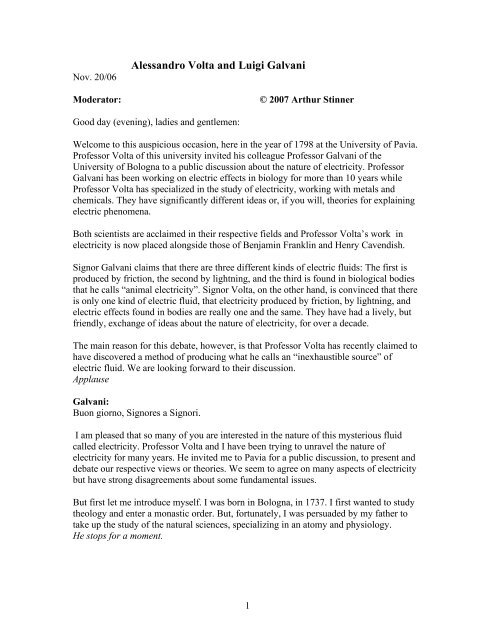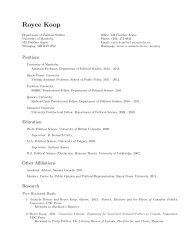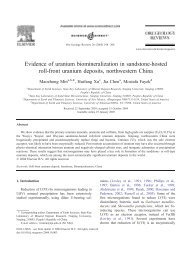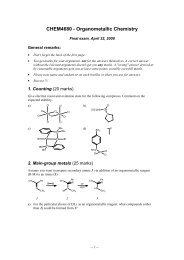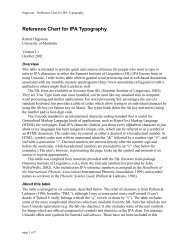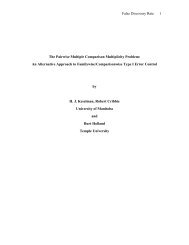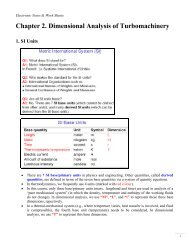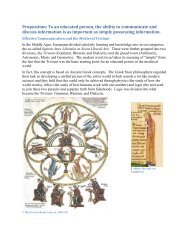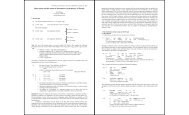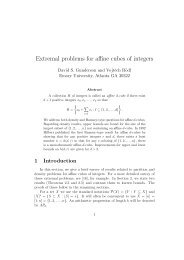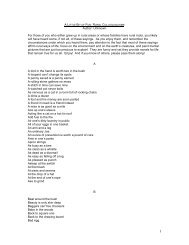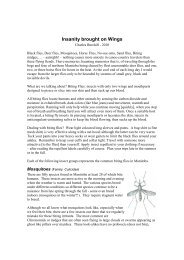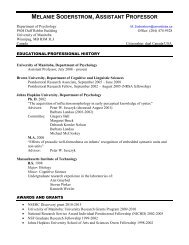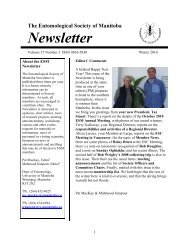Alessandro Volta and Luigi Galvani - University of Manitoba
Alessandro Volta and Luigi Galvani - University of Manitoba
Alessandro Volta and Luigi Galvani - University of Manitoba
You also want an ePaper? Increase the reach of your titles
YUMPU automatically turns print PDFs into web optimized ePapers that Google loves.
Nov. 20/06<br />
<strong>Aless<strong>and</strong>ro</strong> <strong>Volta</strong> <strong>and</strong> <strong>Luigi</strong> <strong>Galvani</strong><br />
Moderator: © 2007 Arthur Stinner<br />
Good day (evening), ladies <strong>and</strong> gentlemen:<br />
Welcome to this auspicious occasion, here in the year <strong>of</strong> 1798 at the <strong>University</strong> <strong>of</strong> Pavia.<br />
Pr<strong>of</strong>essor <strong>Volta</strong> <strong>of</strong> this university invited his colleague Pr<strong>of</strong>essor <strong>Galvani</strong> <strong>of</strong> the<br />
<strong>University</strong> <strong>of</strong> Bologna to a public discussion about the nature <strong>of</strong> electricity. Pr<strong>of</strong>essor<br />
<strong>Galvani</strong> has been working on electric effects in biology for more than 10 years while<br />
Pr<strong>of</strong>essor <strong>Volta</strong> has specialized in the study <strong>of</strong> electricity, working with metals <strong>and</strong><br />
chemicals. They have significantly different ideas or, if you will, theories for explaining<br />
electric phenomena.<br />
Both scientists are acclaimed in their respective fields <strong>and</strong> Pr<strong>of</strong>essor <strong>Volta</strong>’s work in<br />
electricity is now placed alongside those <strong>of</strong> Benjamin Franklin <strong>and</strong> Henry Cavendish.<br />
Signor <strong>Galvani</strong> claims that there are three different kinds <strong>of</strong> electric fluids: The first is<br />
produced by friction, the second by lightning, <strong>and</strong> the third is found in biological bodies<br />
that he calls “animal electricity”. Signor <strong>Volta</strong>, on the other h<strong>and</strong>, is convinced that there<br />
is only one kind <strong>of</strong> electric fluid, that electricity produced by friction, by lightning, <strong>and</strong><br />
electric effects found in bodies are really one <strong>and</strong> the same. They have had a lively, but<br />
friendly, exchange <strong>of</strong> ideas about the nature <strong>of</strong> electricity, for over a decade.<br />
The main reason for this debate, however, is that Pr<strong>of</strong>essor <strong>Volta</strong> has recently claimed to<br />
have discovered a method <strong>of</strong> producing what he calls an “inexhaustible source” <strong>of</strong><br />
electric fluid. We are looking forward to their discussion.<br />
Applause<br />
<strong>Galvani</strong>:<br />
Buon giorno, Signores a Signori.<br />
I am pleased that so many <strong>of</strong> you are interested in the nature <strong>of</strong> this mysterious fluid<br />
called electricity. Pr<strong>of</strong>essor <strong>Volta</strong> <strong>and</strong> I have been trying to unravel the nature <strong>of</strong><br />
electricity for many years. He invited me to Pavia for a public discussion, to present <strong>and</strong><br />
debate our respective views or theories. We seem to agree on many aspects <strong>of</strong> electricity<br />
but have strong disagreements about some fundamental issues.<br />
But first let me introduce myself. I was born in Bologna, in 1737. I first wanted to study<br />
theology <strong>and</strong> enter a monastic order. But, fortunately, I was persuaded by my father to<br />
take up the study <strong>of</strong> the natural sciences, specializing in an atomy <strong>and</strong> physiology.<br />
He stops for a moment.<br />
1
I know, usually, this is the other way around. I am glad I listen to my father.<br />
Actually, I first trained as a physician, but was <strong>of</strong>fered an appointment at the <strong>University</strong><br />
<strong>of</strong> Bologna at the age <strong>of</strong> twenty-five to teach anatomy. Later I became pr<strong>of</strong>essor <strong>of</strong><br />
obstetrics at the Institute <strong>of</strong> Arts <strong>and</strong> Sciences. My research began with a doctoral thesis<br />
in comparative anatomy but later drifted toward physiology. I am still at the <strong>University</strong><br />
<strong>and</strong> presently engaged in research into what I call “animal electricity”.<br />
In the last 10 years or so, Pr<strong>of</strong>essor <strong>Volta</strong> <strong>and</strong> I have had a “friendly” exchange <strong>of</strong> ideas<br />
about the nature <strong>of</strong> electricity itself. This long debate was occasioned by an amazing<br />
chance discovery I made about 12 years ago in 1786. However, I did not publish my<br />
experiments until last year, but I privately reported my findings to pr<strong>of</strong>essor <strong>Volta</strong>.<br />
On that day in 1786 I was dissecting frogs in my lab. I remember nearby my students<br />
were experimenting with our static electricity machine. I was to make a soup for my<br />
ailing wife, who had a nasty cold. As a physician I recommended frog soup <strong>and</strong> as an<br />
anatomist I carefully dissected the frog.<br />
Now, two things occurred simultaneously causing me to stop <strong>and</strong> wonder. One <strong>of</strong> my<br />
students was drawing a spark from the brass conductor <strong>of</strong> the electrical machine when a<br />
knife held in his h<strong>and</strong> touched the exposed sciatic nerve passing through the lower part <strong>of</strong><br />
the spine into the frog's legs. There was an immediate twitch <strong>of</strong> the muscles <strong>and</strong> a kick <strong>of</strong><br />
the legs as if a severe cramp had set in. Actually, all the muscles <strong>of</strong> the frog’s limbs were<br />
seen to be so contracted that they seemed to have fallen into tonic convulsions. My<br />
students were astonished <strong>and</strong> one <strong>of</strong> them cried: “La rana e viva!“, or “the frog is alive!”<br />
For the next 10 years I conducted many experiments. I used an electrostatic machine to<br />
produce electricity <strong>and</strong> also a Leyden jar, a device to store static electricity. I<br />
systematically began experimenting with muscular stimulation by electrical means.<br />
Through numerous observations <strong>and</strong> experiments I caused muscular contraction in a frog<br />
by touching its nerves with an electrostatically charged metal. I also experimented with<br />
lightning <strong>and</strong> found the same effect. I also found out that I was able to cause muscular<br />
contraction by touching the nerve with different metals but without a source <strong>of</strong><br />
electrostatic charge. This discovery, <strong>of</strong> course, was surprising.<br />
Now, I knew that this was not the first time that animal electricity was discussed. I knew<br />
about the powers <strong>of</strong> the electric eel, also known as the torpedo fish, that could actually<br />
provide a lethal electric shock, not unlike the one delivered by a large charged Leyden<br />
jar. But it was the first time that, what I now call “animal electricity”, was connected to<br />
natural or man-made electricity.<br />
He stops for a moment <strong>and</strong> then concludes his introduction.<br />
Based on these experiments I finally concluded that animal tissue contained an innate<br />
vital force, which I called "animal electricity." I believe this is a new form <strong>of</strong> electricity<br />
in addition to the "natural" form that produced lightning <strong>and</strong> to the "artificial" form that is<br />
produced by friction (i.e., static electricity). In addition, I believe the brain secrets an<br />
2
"electric fluid" <strong>and</strong> that the flow <strong>of</strong> this fluid through the nerves provided a stimulus for<br />
the muscle fibers.<br />
Grazie, pr<strong>of</strong>essore , Signores a Signori.<br />
He bows <strong>and</strong> looks at <strong>Volta</strong><br />
<strong>Volta</strong>:<br />
Turns to <strong>Galvani</strong> <strong>and</strong> acknowledges his greeting.<br />
Mille grazie, Pr<strong>of</strong>essor <strong>Galvani</strong>.<br />
Turns to the audience<br />
I am pleased that my good friend has agreed to come to Pavia to discuss the nature <strong>of</strong><br />
electricity. I am sad to hear that he has been forced to retire last year, because it was<br />
against his conscience to sign a document that the <strong>University</strong> required <strong>of</strong> all pr<strong>of</strong>essors,<br />
following the occupation <strong>of</strong> Northern Italy by the Napoleonic army. Being a man <strong>of</strong><br />
integrity, he refused to take the oath <strong>of</strong> allegiance required <strong>of</strong> him by the invader.<br />
But I am sure that he will continue his excellent scientific work.<br />
<strong>Galvani</strong> smiles <strong>and</strong> nods. <strong>Volta</strong> turns to the audience:<br />
I was born in Como, Italy, in 1745. into a noble family. I actually started my education in<br />
a Jesuit school, with the intention that I would become a priest, as many <strong>of</strong> my friends<br />
did. However, my passion had always been the study <strong>of</strong> electricity, <strong>and</strong> while still a<br />
young student I even wrote a poem in Latin about this fascinating new discovery.<br />
I will spare you the reading <strong>of</strong> this silly poem today.<br />
My first scientific paper was published in 1769 , when I was only 24 years old: "De vi<br />
attractiva ignis electrici", which was widely read <strong>and</strong> helped me secure my first public<br />
appointment. I became a teacher <strong>of</strong> physics in a secondary school in my hometown, but<br />
was soon appointed pr<strong>of</strong>essor <strong>of</strong> physics in the <strong>University</strong> <strong>of</strong> Como. During this time I<br />
built the first lightning rod in Como, <strong>and</strong> perhaps in all <strong>of</strong> Italy, having read about the<br />
experiments <strong>of</strong> the American natural philosopher <strong>and</strong> statesman, Benjamin Franklin.<br />
In 1775 I invented the electrophorus, a device that produced a large static electric charge.<br />
Two years later I studied the chemistry <strong>of</strong> gases, discovered methane, <strong>and</strong> devised<br />
experiments such as the ignition <strong>of</strong> gases by an electric spark in a closed vessel. In 1779<br />
I became pr<strong>of</strong>essor <strong>of</strong> experimental physics at the <strong>University</strong> <strong>of</strong> Pavia. In recognition <strong>of</strong><br />
my work, a few years ago I received the Copley medal from the British Royal Society.<br />
A great honor for me.<br />
On the practical side <strong>of</strong> my work, I developed gas lanterns electrically ignited, <strong>and</strong> also<br />
constructed an "electric pistol." I know that the electric pistol is just a toy but it can be<br />
used to teach important ideas to students in both electricity <strong>and</strong> chemistry.<br />
I have been intimately acquainted with Pr<strong>of</strong>essor <strong>Galvani</strong>’s work for many years now. In<br />
fact, it was his ideas about what he calls “animal electricity” that lead me to my own<br />
3
ecent discovery that I think will be important for the future <strong>of</strong> science.<br />
He stops <strong>and</strong> then continues with emphasis.<br />
I am now announcing for the first time that I believe that I have found a method to<br />
produce a continuous flow <strong>of</strong> electric fluid. From now on we physicists will not have to<br />
store electric fluid in devices like the Leyden jar to perform experiments such as the<br />
separation <strong>of</strong> water into hydrogen <strong>and</strong> oxygen. We will have a continuous supply<br />
available.<br />
He turns to <strong>Galvani</strong>.<br />
But now let us start our debate, <strong>Luigi</strong>. How did you go about developing your theory <strong>of</strong><br />
“animal electricity”?<br />
<strong>Galvani</strong>:<br />
Oh, dio mio. The phenomenon I discovered was so strange <strong>and</strong> puzzling that I<br />
immediately repeated the conditions that caused the sudden kick in the frog legs. I soon<br />
realized that this chance discovery opened up a whole new field <strong>of</strong> investigation, so I<br />
proceeded to systematically investigate this phenomenon.<br />
<strong>Volta</strong>:<br />
Of course, as a physicist I would have never discovered this effect. Grazie, <strong>Luigi</strong>.<br />
<strong>Galvani</strong>:<br />
Prego, <strong>Aless<strong>and</strong>ro</strong>.<br />
I found, for example, that there was no such action when the h<strong>and</strong> grasped the bone<br />
h<strong>and</strong>le <strong>of</strong> the knife instead <strong>of</strong> holding the blade itself. I also found that there was no<br />
action if the spark was not produced by the machine. Clearly, I thought that there must be<br />
a causal relationship between the electrical stimulus <strong>and</strong> the muscular contraction.<br />
I confirmed this by alternately touching the exposed nerve with a glass rod <strong>and</strong> an iron<br />
probe.<br />
<strong>Volta</strong>:<br />
So you showed that a conductor was required.<br />
<strong>Galvani</strong>:<br />
Exactly. But what puzzled me was that contact with the nerve sometimes worked <strong>and</strong> at<br />
other times failed to produce a contraction. I tried everything I could think <strong>of</strong>. I used<br />
different materials, a Leyden jar instead <strong>of</strong> the electric machine. I also used different<br />
animals for my experiments.<br />
<strong>Volta</strong>:<br />
I remember you writing to me that you also experimented by exposing frog legs to<br />
lightning?<br />
4
<strong>Galvani</strong>:<br />
Indeed. I did some strange experiments that must have caused my colleagues to wonder<br />
about my sanity.<br />
He laughs.<br />
I exposed frog legs <strong>and</strong> dissected parts <strong>of</strong> warm-blooded animals to a lightning storm by<br />
hanging them from an iron railing. I connected the lower tip <strong>of</strong> the suspended part to a<br />
grounding wire. I then watched <strong>and</strong> waited.<br />
He stops for a moment<br />
<strong>Volta</strong>:<br />
What happened? Don’t keep us in suspense.<br />
<strong>Galvani</strong>:<br />
Well, as I expected, every time I saw lightning, the legs convulsed immediately.<br />
<strong>Volta</strong>:<br />
And there was no delay between the lightning <strong>and</strong> the effect?<br />
<strong>Galvani</strong>:<br />
Now that you mention it, ….that is strange. When we see lightning it <strong>of</strong>ten takes many<br />
seconds before the effect is heard. It seems that the effect is instantaneous.<br />
But, <strong>of</strong> course, that would only interest a physicist like you, <strong>Aless<strong>and</strong>ro</strong>.<br />
<strong>Volta</strong>:<br />
Investigating that, would initiate a whole new field <strong>of</strong> research,<br />
But let us not stray from the topic.<br />
<strong>Galvani</strong>:<br />
Alora. Anyway, an already complex set <strong>of</strong> conditions now became even more<br />
challenging. I discovered something very puzzling. I noticed that when a copper or brass<br />
hook was pressed into the frog’s marrow <strong>and</strong> hung from an iron railing I saw twitching<br />
even on a sunny <strong>and</strong> cloudless day.<br />
<strong>Volta</strong>:<br />
Clearly then lightning was not required to produce these contractions.<br />
<strong>Galvani</strong>:<br />
Si. I then took the frogs indoors <strong>and</strong> I found that the legs twitched. So this eliminated<br />
electricity generated by lightning as well as by an electric machine as necessary to<br />
produce the phenomenon.<br />
5
This is very exciting. You were now ready to propose a theory for the effect?<br />
<strong>Galvani</strong>:<br />
Well, not quite. At this point I thought that there were two possibilities. I had to decide<br />
between them. The first one was that animals possessed a special electrical property that<br />
remained with them even after they died. The second explanation was that the contact <strong>of</strong><br />
the metals somehow produced the effect.<br />
<strong>Volta</strong>:<br />
Molto interessante, <strong>Luigi</strong>.<br />
He smiles <strong>and</strong> then continues<br />
So the legs acted like an electroscope that would show the presence <strong>of</strong> a charge by the<br />
divergence <strong>of</strong> the metallic ribbons.<br />
<strong>Galvani</strong>:<br />
Certo. That, <strong>of</strong> course, occurred to me, too.<br />
But, naturally, I chose the biological interpretation: I now argued for a vital force or an<br />
“animal electricity” that is present in animal tissue in general.<br />
<strong>Volta</strong>:<br />
<strong>Volta</strong> scratches his head reflectively.<br />
Let me see if I underst<strong>and</strong> this, <strong>Luigi</strong>. It seems to me that you visualize a living creature<br />
as functioning like a fleshy version <strong>of</strong> a Leyden jar. The nerve <strong>and</strong> the muscle would be<br />
analogous to the inner <strong>and</strong> outer charged surfaces <strong>of</strong> the jar.<br />
<strong>Galvani</strong>:<br />
Seen through the eyes <strong>of</strong> a physicist!<br />
<strong>Volta</strong>:<br />
Certo, <strong>Luigi</strong>.<br />
<strong>Galvani</strong>:<br />
So… when the outer surface <strong>of</strong> the muscle received an electric charge, the nerve <strong>and</strong><br />
inner muscular surface would then become oppositely charged <strong>and</strong> …muscular<br />
contraction would follow.<br />
Maybe we can now hear your ideas, <strong>Aless<strong>and</strong>ro</strong>.<br />
6
.<br />
<strong>Volta</strong>:<br />
Well, over the years you <strong>and</strong> I have communicated <strong>and</strong> I was more or less acquainted<br />
with your work <strong>and</strong> ideas. I tried to repeat the experiments conducted by you , as far as I<br />
could, …but I am not very adept with a scalpel!<br />
He laughs <strong>and</strong> looks at <strong>Galvani</strong>.<br />
Finally, I came to the conclusion that there was a third possible explanation <strong>of</strong> this<br />
phenomenon.<br />
He pauses.<br />
The third possibility, <strong>of</strong> course, is that the electric effect is produced by two dissimilar<br />
metals, but without contact with a biological sample. Or, as I have just written in my<br />
letter to Sir Joseph Banks, the President <strong>of</strong> the Royal Society in London: …” a mere<br />
contact <strong>of</strong> conducting substances <strong>of</strong> different kinds” .<br />
<strong>Galvani</strong>:<br />
But how long would this electric effect last?<br />
<strong>Volta</strong>:<br />
Well, not very long.<br />
Let me show you.<br />
He takes a piece <strong>of</strong> copper <strong>and</strong> gives it to <strong>Galvani</strong>.<br />
<strong>Luigi</strong>, put these dissimilar metals on your tongue..<br />
<strong>Galvani</strong>:<br />
Alright.<br />
He places these slowly on his tongue <strong>and</strong> then makes a face.<br />
Actually, I have tried this, too. But that does not falsify my “animal electricity” theory. It<br />
rather confirms it, I think!<br />
<strong>Volta</strong>:<br />
I agree. That is, it may confirm it. But I used the tongue test not to test your theory but as<br />
a primitive electroscope to determine the strength <strong>of</strong> the electric effect.<br />
I found that a silver zinc combination gave the best effect.<br />
He looks at <strong>Galvani</strong><br />
I believe you found this, too.<br />
<strong>Galvani</strong>:<br />
Indeed, I did.<br />
7
<strong>Volta</strong>:<br />
But I was looking for a source <strong>of</strong> a continuous electric effect. At this point I paced a<br />
salt –moistened s<strong>of</strong>t discs between the silver <strong>and</strong> zinc metal plates.<br />
The idea then occurred to me that that I could build a vertical Pile, coupling the plates<br />
while alternating them <strong>and</strong> interpose between each <strong>of</strong> them a moistened disc. I piled them<br />
high, up to dozens in one Pile.<br />
<strong>Galvani</strong>:<br />
Fascinating. How did you test the size <strong>of</strong> the electric effect now?<br />
<strong>Volta</strong>:<br />
Good question.<br />
Of course, a charged Leyden jar does affect the leafs <strong>of</strong> an electroscope. The tongue test<br />
is a good start for finding the strength <strong>of</strong> a week electric tension but I needed something<br />
better. What I did was connect a condenser made <strong>of</strong> two plates, much like a Leyden jar,<br />
to the electroscope. The electric fluid that was produced by the Pile then built up the<br />
charge <strong>and</strong> the leafs deflected.<br />
<strong>Galvani</strong>:<br />
But a charged Leyden jar will also affect an electroscope. How did you show that the<br />
electric fluid produced by your Pile flows continuously?<br />
<strong>Volta</strong>:<br />
You are right. What I found though was that, unlike the charged Leyden jar, my Pile<br />
continues to effect the electroscope indefinitely. Unlike the Leyden jar that has an<br />
insulating separator, the Pile consists <strong>of</strong> conductors that are separated by a salt or acid-<br />
soaked s<strong>of</strong>t discs. In fact, the larger the Pile the higher is the electric tension produced.<br />
He stops for a moment <strong>and</strong> looks at the audience<br />
But let me hastily add that an electric Pile, no matter how many units <strong>of</strong> dissimilar plates<br />
are connected, can never produce an electric tension as high as that <strong>of</strong> a charged Leyden<br />
jar.<br />
He pauses <strong>and</strong> then continues.<br />
I should mention that I have been able to separate water into two gases, now known as<br />
hydrogen <strong>and</strong> oxygen, in a continuous process, rather than using the laborious approach<br />
<strong>of</strong> many applying discharges from a Leyden jar, as Cavendish accomplished about ten<br />
years ago.<br />
<strong>Galvani</strong>:<br />
That is very impressive, <strong>Aless<strong>and</strong>ro</strong>.<br />
But how do you explain the powers <strong>of</strong> the electric eel? There are no metallic plates inside<br />
the torpedo fish.<br />
8
<strong>Volta</strong>:<br />
I am not a biologist but I have seen dissected torpedo fishes. At least now, it seems to me<br />
that they produce electricity much like my electric Pile does. There are hundreds <strong>of</strong> small<br />
organic discs that are connected like the plates are in my Pile. So my electric Pile can be<br />
considered the artificial analogue <strong>of</strong> the natural one found in the torpedo fish.<br />
Moderator: Gentlemen, let me summarize.<br />
Pr<strong>of</strong>essor <strong>Galvani</strong>, who is a biologist <strong>and</strong> physician by training, based on his work <strong>of</strong><br />
over a decade, studying the connection between electricity <strong>and</strong> animals, has come to the<br />
conclusion that there are three identifiable forms <strong>of</strong> electricity: Electricity produced by<br />
lightning, electricity produced artificially by rubbing <strong>and</strong> electrostatic machines, <strong>and</strong><br />
what he calls “animal electricity”, that is produced organically by animals.<br />
On the other h<strong>and</strong>, pr<strong>of</strong>essor <strong>Volta</strong>, a natural philosopher by training, having specialized<br />
in studying electricity, is convinced that pr<strong>of</strong>essor <strong>Galvani</strong> is mistaken when he classifies<br />
electricity as just described. He believes that there is only one kind <strong>of</strong> electricity <strong>and</strong> the<br />
classification <strong>of</strong> Pr<strong>of</strong>essor <strong>Galvani</strong> is artificial <strong>and</strong>, -- well, simply wrong.<br />
Based on what we have heard, I don’t believe we can settle the matter now. Perhaps in<br />
the near future we will have clarification on this important topic.<br />
Turning to the pr<strong>of</strong>essors:<br />
Gentlemen, thank you for the discussion. What we have heard is a clear presentation <strong>of</strong><br />
the two views. Gentlemen, may we have brief concluding remarks:<br />
<strong>Galvani</strong> :<br />
Mille gracie, pr<strong>of</strong>essor <strong>Volta</strong>, for inviting me to Pavia. I have learned a lot tonight about<br />
your work <strong>and</strong> I have a clearer idea about your method <strong>of</strong> experimentation <strong>and</strong> your<br />
theoretical thinking. I am looking forward to seeing your laboratory <strong>and</strong> the performance<br />
<strong>of</strong> your electric Pile.<br />
He pauses <strong>and</strong> then emphatically says:<br />
But I still think that future investigators will find that there is an “animal electricity”!.<br />
<strong>Volta</strong>:<br />
Gracie tanto, Pr<strong>of</strong>essore. I, too, have learned a lot. Although I still believe that there is<br />
only one kind <strong>of</strong> electricity, your findings <strong>and</strong> the mysterious way the torpedo fish<br />
produces electric charges is puzzling.<br />
They shake h<strong>and</strong>s.<br />
<strong>Volta</strong>:<br />
Let me take you for dinner <strong>and</strong> some good wine <strong>and</strong> then we will visit my laboratory<br />
where my assistants are preparing some demonstrations for you.<br />
9
<strong>Galvani</strong>:<br />
Gracie, <strong>and</strong>iamo, <strong>Aless<strong>and</strong>ro</strong>.<br />
They leave, laughing <strong>and</strong> talking amiably.<br />
Moderator:<br />
<strong>Volta</strong>’’s discovery was a sensation, for it enabled high electric currents to be produced<br />
for the first time. It was quickly applied to produce electrolysis, resulting in the discovery<br />
<strong>of</strong> several new chemical elements, <strong>and</strong> this led throughout the 1800s to the great<br />
discoveries <strong>of</strong> electromagnetism <strong>and</strong> electronics that culminated in the invention <strong>of</strong> the<br />
electrical machines <strong>and</strong> electronic devices that we use today.<br />
<strong>Volta</strong> graciously honored his friend by calling electric current “galvanic fluid”. The<br />
instrument that first measured electric current, after the discovery <strong>of</strong> Oersted in 1819 that<br />
an electric current produces a magnetic effect, was named a galvanometer.<br />
A few months later <strong>Galvani</strong> died a broken man but <strong>Volta</strong> lived a long life <strong>and</strong> died in<br />
1827. After 1801, when he toured Europe <strong>and</strong> was celebrated (Napoleon made him a<br />
count) all over Europe, he retired <strong>and</strong> stopped his scientific work. There is a large<br />
building in Pavia called “The <strong>Volta</strong> Temple” that commemorates his work.<br />
We now know that both <strong>Volta</strong> <strong>and</strong> <strong>Galvani</strong> were right. Biologists <strong>and</strong> physicians have<br />
mapped out how the body produces its own electricity.<br />
As it <strong>of</strong>ten happens in science, when two major theories are confronting each other, it<br />
turns out that the theories are complementary ;<br />
Wave theory <strong>and</strong> particle theory for light, for example.<br />
10
And I pursued this idea, <strong>and</strong> I am pleased to announce that it lead to<br />
11
`<br />
12
He observed that <strong>Galvani</strong> had connected brass hooks between the frog's spinal cord <strong>and</strong><br />
an iron railing. According to <strong>Volta</strong>'s interpretation, the muscle twitches were induced by<br />
current flowing between two dissimilar metals connected by the moist<br />
.<br />
In the strange case <strong>of</strong> <strong>Galvani</strong>'s frog, this twitching happened even when its legs were not<br />
in a direct circuit with the machine. <strong>Galvani</strong> had placed the lower section <strong>of</strong> a dissected<br />
frog on a table near a plate-type electrical machine.<br />
which he called "animal electricity" - was generated in the tissue <strong>of</strong> the frog <strong>and</strong>, flowing<br />
through the metal skewer <strong>and</strong> fence, activated the frog's muscles. He distinguished this<br />
kind <strong>of</strong> electricity from "artificial electricity" generated by friction (static electricity) <strong>and</strong><br />
from "natural electricity" such as lightning. He thought <strong>of</strong> "animal electricity" as a fluid<br />
secreted by the brain, <strong>and</strong> proposed that flow <strong>of</strong> this fluid through the nerves activated the<br />
muscles.<br />
flesh <strong>of</strong> the frog's leg. This led him to develop the first device which demonstrated<br />
chemical production <strong>of</strong> electric current. In 1799, <strong>Volta</strong> arranged a vertical Pile <strong>of</strong> metal<br />
discs (zinc with copper or silver) <strong>and</strong> separated them from each other with paperboard<br />
discs that had been soaked in saline solution. This stack became known as the voltaic Pile<br />
<strong>and</strong> was the progenitor formodern alkaline batteries.<br />
In 1791, while working at Bologna <strong>University</strong>, <strong>Luigi</strong> <strong>Galvani</strong> discovered that the muscle<br />
<strong>of</strong> a frog contracted when touched by a metallic object. This phenomenon became known<br />
as animal electricity — a misnomer, as the theory was later disproven. Prompted by these<br />
experiments, <strong>Volta</strong> initiated a series <strong>of</strong> experiments using zinc, lead, tin or iron as<br />
positive plates. Copper, silver, gold or graphite were used as negative plates.<br />
The next stage <strong>of</strong> generating electricity was through electrolysis. <strong>Volta</strong> discovered in<br />
1800 that a continuous flow <strong>of</strong> electrical force was generated when using certain fluids as<br />
conductors to promote a chemical reaction between the metals or electrodes. This led to<br />
the invention <strong>of</strong> the first voltaic cell, better know as the battery. <strong>Volta</strong> discovered further<br />
that the voltage would increase when voltaic cells were stacked on top <strong>of</strong> each other.<br />
13
In his pursuit <strong>of</strong> the current generated by his primitive batteries, <strong>Volta</strong><br />
In seeking further experimental evidence in favour <strong>of</strong> his contact theory, <strong>Volta</strong> was led to<br />
the greatest <strong>of</strong> his inventions, the voltaic "Pile", which he described in a communication<br />
<strong>of</strong> 20 March, 1800, to Sir Joseph Banks, President <strong>of</strong> the Royal Society <strong>of</strong> London.<br />
The twitching <strong>of</strong> frog's legs under electrical stimulus, discovered by Swammerdam in<br />
1658 <strong>and</strong> re-discovered <strong>and</strong> described by <strong>Galvani</strong> in 1786, occasioned a memorable<br />
controversy as to the cause <strong>of</strong> the convulsive movements; after years <strong>of</strong> discussion the<br />
"animal electricity" <strong>of</strong> <strong>Galvani</strong> was superseded by the "contact theory" <strong>of</strong> <strong>Volta</strong>.<br />
was the inventor <strong>of</strong> the voltaic Pile, the first electric battery. In 1775 he invented the<br />
electrophorus, a device that, once electrically charged by having been rubbed, could<br />
transfer charge to other objects. Between 1776 <strong>and</strong> 1778, <strong>Volta</strong> discovered <strong>and</strong> isolated<br />
methane gas.<br />
that led <strong>Volta</strong> to build the voltaic Pile to prove that electricity did not come from the<br />
animal tissue but was generated by the contact <strong>of</strong> different metals, brass <strong>and</strong> iron, in<br />
a moist environment. Ironically, both scientists were right.<br />
<strong>Volta</strong>, a former high school physics teacher, found that it was the presence <strong>of</strong> two<br />
dissimilar metals, not the frog leg, that was critical. In 1800, after extensive<br />
experimentation, he developed the voltaic Pile. The original voltaic Pile consisted <strong>of</strong> a<br />
Pile <strong>of</strong> zinc <strong>and</strong> silver discs <strong>and</strong> between alternate discs, a piece <strong>of</strong> cardboard that had<br />
been soaked in saltwater. A wire connecting the bottom zinc disc to the top silver disc<br />
could produce repeated sparks. No frogs were injured in the production <strong>of</strong> a voltaic Pile.<br />
----------------------------------------------------------------------------------------------------<br />
14
.<br />
He is famous more especially on account <strong>of</strong> his experiments concerning "the electrical<br />
forces in muscular movements", leading up to his theory <strong>of</strong> animal electricity. This began<br />
with the accidental observation, in 1780, <strong>of</strong> the twitching <strong>of</strong> the legs <strong>of</strong> a dissected frog<br />
when the bared crural nerve was touched with the steel scalpel, while sparks were passing<br />
from an electric machine nearby. He worked diligently along these lines, but waited for<br />
eleven years before he published the results <strong>and</strong> his ingenious <strong>and</strong> simple theory. This<br />
theory <strong>of</strong> a nervous electric fluid, secreted by the brain, conducted by the nerves, <strong>and</strong><br />
stored in the muscles, has been ab<strong>and</strong>oned by scientists on account <strong>of</strong> later discoveries,<br />
but <strong>Galvani</strong> was led to it in a very logical manner <strong>and</strong> defended it by clever experiments,<br />
which soon bore fruit. Thus he discovered that when nerve <strong>and</strong> muscle touch two<br />
dissimilar metals in contact with each other, a contraction <strong>of</strong> the muscle takes place; this<br />
led ultimately to his discussions with <strong>Volta</strong> <strong>and</strong> to the discovery <strong>of</strong> the <strong>Volta</strong>ic Pile. The<br />
name <strong>Galvani</strong>sm is given to the manifestations <strong>of</strong> current electricity.<br />
<strong>Galvani</strong> was by nature courageous <strong>and</strong> religious. It is reported by Alibert that he never<br />
ended his lessons "without exhorting his hearers <strong>and</strong> leading them back to the idea <strong>of</strong> that<br />
eternal Providence, which develops, conserves, <strong>and</strong> circulates life among so many divers<br />
beings". His works (Opere di <strong>Luigi</strong> <strong>Galvani</strong>) were collected <strong>and</strong> published by the<br />
Academy <strong>of</strong> Sciences <strong>of</strong> the Institute <strong>of</strong> Bologna (1841-42). The following are some <strong>of</strong><br />
the titles, with the original dates <strong>of</strong> publication in the "Antichi Commentari" <strong>of</strong> the<br />
Bologna Institute: "Thesis: De Ossibus" (1762); "De Renibus atque Ureteribus<br />
Volatilium" (1767); "De Volatilium Aure" (1768-70); "De Viribus Electricitatis in motu<br />
musculari commentarius" (1791), reprinted at Modena, 1792, with a note <strong>and</strong> dissertation<br />
by Gio. Aldini; translated by Mayer into German (Prague, 1793), <strong>and</strong> again<br />
Italian physiologist, after whom galvanism received its name, born at Bologna on the 9th<br />
<strong>of</strong> September 1737. It was his wish in early life to enter the church, but by his parents he<br />
was educated for a medical career. At the <strong>University</strong> <strong>of</strong> Bologna, in which city he<br />
practiced, he was in 1762 appointed public lecturer in anatomy, <strong>and</strong> soon gained repute as<br />
a skilled though not eloquent teacher, <strong>and</strong>, chiefly from his researches on the organs <strong>of</strong><br />
hearing <strong>and</strong> genito-urinary tract <strong>of</strong> birds, as a comparative anatomist. His celebrated<br />
theory <strong>of</strong> animal electricity he enunciated in a treatise, "De viribus electricitatis in motu<br />
musculari commentarius", published in the 7th volume <strong>of</strong> the memoirs <strong>of</strong> the Institute <strong>of</strong><br />
Sciences at Bologna in 1791, <strong>and</strong> separately at Modena in the following year, <strong>and</strong><br />
elsewhere subsequently. The statement has frequently been repeated that, in 1786,<br />
<strong>Galvani</strong> had noticed that the leg <strong>of</strong> a skinned frog, on being accidentally touched by a<br />
scalpel which had lain near an electrical machine, was thrown into violent convulsions;<br />
<strong>and</strong> that it was thus that his attention was first directed to the relations Of animal<br />
15
functions to electricity. From documents in the pdssession <strong>of</strong> the Institute <strong>of</strong> Bologna,<br />
however, it appears that twenty years previous to the publication <strong>of</strong> his Commentary<br />
<strong>Galvani</strong> was already engaged in investigations as to the action <strong>of</strong> electricity upon the<br />
muscles <strong>of</strong> frogs. The observation that the suspension <strong>of</strong> certain <strong>of</strong> these animals on an<br />
iron railing by copper hooks caused twitching in the muscles <strong>of</strong> their legs led him to the<br />
invention <strong>of</strong> his metallic arc, the first experiment with which is described in the third part<br />
<strong>of</strong> the Commentary, with the date September 20, 1786. The arc he constructed <strong>of</strong> two<br />
different metals, which, placed in contact the one with a frog's nerve <strong>and</strong> the other with a<br />
muscle, caused contraction <strong>of</strong> the latter. In <strong>Galvani</strong>'s view the motions <strong>of</strong> the muscle were<br />
the result <strong>of</strong> the union, by means <strong>of</strong> the metallic arc, <strong>of</strong> its exterior or negative electrical<br />
charge with positive electricity which proceeded along the nerve from its inner substance.<br />
<strong>Aless<strong>and</strong>ro</strong> <strong>Volta</strong>, on the other h<strong>and</strong>, attributed them solely to the effect <strong>of</strong> electricity<br />
having its source in the junction <strong>of</strong> the two dissimilar metals <strong>of</strong> the arc, <strong>and</strong> regarded the<br />
nerve <strong>and</strong> muscle simply as conductors. On <strong>Galvani</strong>'s refusal, from religious scruples, to<br />
take the oath <strong>of</strong> allegiance to the Cisalpine republic in 1797, he was removed from his<br />
pr<strong>of</strong>essorship. Deprived thus <strong>of</strong> the means <strong>of</strong> livelihood, he retired to the house <strong>of</strong> his<br />
brother Giacomo, where he soon fell into a feverish decline. The republican government,<br />
in consideration <strong>of</strong> his great scientific fame, eventually, but too late, determined to<br />
reinstate him in his chair, <strong>and</strong> he died at Bologna on the 4th <strong>of</strong> December 1798.<br />
© 2007 Arthur Stinner<br />
16


